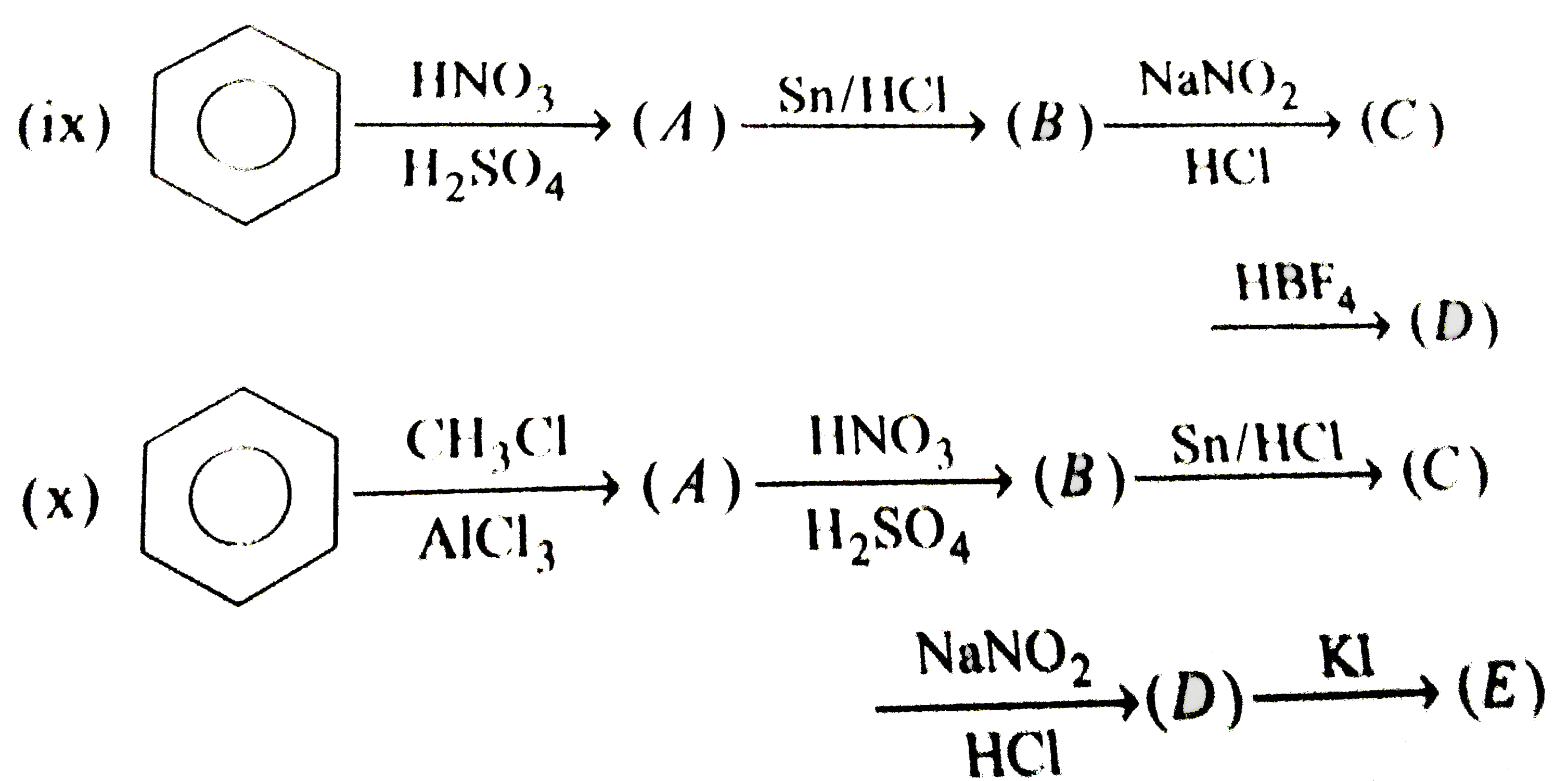In the following reaction order , B is
CH3CH2COOHP/Br2−−−→AalcKOH−−−−→H+B
CH2=CH−COOH
CH2−CH∣Br−COOH
CH3CH2COBr
CH3CH2CH2OH
The correct Answer is:A
To solve the problem step by step, we will analyze the reactions taking place in the given sequence.
Step 1: Identify the starting compound
The starting compound is CH₃CH₂COOH, which is propanoic acid (a carboxylic acid).
Hint: Recognize the functional groups and structure of the starting compound.
Step 2: Understand the first reaction
The first reaction involves CH₃CH₂COOH reacting with P/Br₂. This is known as the Hale–Volhard–Zelinsky (HVZ) reaction. In this reaction, the alpha-hydrogen of the carboxylic acid is replaced by a bromine atom.
Hint: Recall that in HVZ reaction, bromination occurs at the alpha position of carboxylic acids.
Step 3: Perform the HVZ reaction
In the HVZ reaction, the alpha-hydrogen (the hydrogen attached to the carbon adjacent to the carboxylic acid) is replaced by bromine. Thus, the product A formed from this reaction will be CH₃CHBrCOOH.
Hint: Identify the position of the alpha-hydrogen and understand how it is replaced by bromine.
Step 4: Identify the second reaction
The next step involves treating product A (CH₃CHBrCOOH) with alc KOH (alcoholic potassium hydroxide) followed by hydrolysis. This step typically leads to an elimination reaction.
Hint: Remember that alcoholic KOH promotes elimination reactions, leading to the formation of alkenes.
Step 5: Perform the elimination reaction
In the elimination reaction, the bromine atom and a hydrogen atom from the adjacent carbon are removed, resulting in the formation of a double bond. The product formed will be CH₂=CHCOOH, which is acrylic acid.
Hint: Visualize the elimination process to see how the double bond is formed.
Conclusion
The final product B after the reactions is CH₂=CHCOOH (acrylic acid).
Final Answer: Product B is CH₂=CHCOOH (acrylic acid).
---
The starting compound is CH₃CH₂COOH, which is propanoic acid (a carboxylic acid).
The first reaction involves CH₃CH₂COOH reacting with P/Br₂. This is known as the Hale–Volhard–Zelinsky (HVZ) reaction. In this reaction, the alpha-hydrogen of the carboxylic acid is replaced by a bromine atom.
In the HVZ reaction, the alpha-hydrogen (the hydrogen attached to the carbon adjacent to the carboxylic acid) is replaced by bromine. Thus, the product A formed from this reaction will be CH₃CHBrCOOH.
The next step involves treating product A (CH₃CHBrCOOH) with alc KOH (alcoholic potassium hydroxide) followed by hydrolysis. This step typically leads to an elimination reaction.
In the elimination reaction, the bromine atom and a hydrogen atom from the adjacent carbon are removed, resulting in the formation of a double bond. The product formed will be CH₂=CHCOOH, which is acrylic acid.
The final product B after the reactions is CH₂=CHCOOH (acrylic acid).
Topper's Solved these Questions
- BOOK - A2ZCHAPTER - ALDEHYDES, KETONES AND CARBOXYLIC ACIDEXERCISE - Assertion-Reasoning Questions7videos
ALDEHYDES, KETONES AND CARBOXYLIC ACID
- BOOK - A2ZCHAPTER - ALDEHYDES, KETONES AND CARBOXYLIC ACIDEXERCISE - Section D - Chapter End Test30videos
ALDEHYDES, KETONES AND CARBOXYLIC ACID
- BOOK - A2ZCHAPTER - ALDEHYDES, KETONES AND CARBOXYLIC ACIDEXERCISE - AIPMT/NEET Questions43videos
ALDEHYDES, KETONES AND CARBOXYLIC ACID
- BOOK - A2ZCHAPTER - ALCOHOLS, PHENOLS AND ETHERSEXERCISE - Section D - Chapter End Test30videos
ALCOHOLS, PHENOLS AND ETHERS
- BOOK - A2ZCHAPTER - BIOMOLECULESEXERCISE - Section D - Chapter End Test30videos
BIOMOLECULES
Similar Questions
Complete the following reactions :
CH3CH2BrAlc.KOH−−−−−→View SolutionComplete the following by providing (A),(B),(C) and (D) :
(i)CH3CH2CH2OHPBr−−→(A)alc.KOH−−−−−−→Δ
(B)HBr−−→(C)NH3−−→(D)
(ii)CH3CH2CH2Ialc.KOH−−−−−−→Δ(A)H+/H2O−−−−−→
(B)SOCI2−−−→(C)H−−−−−−→LiAIH4(D)
(iii)CH3CHBrCH3alc.KOH−−−−−−→Δ(A)HBr−−−−−−−→Peroxide
(B)Nal−−−−−−→Acetone(C)H−−−−−→Ether
(iv)CH3CH2CH=CH2NBS−−−−−→Light(A)alc.KOH−−−−−−→Δ(B)
HBr−−→(C)
(v)CH3CH2MgBrCH3CHO/H2O−−−−−−−−−→(A)HBr−−→(B)
alc.KOH−−−−−−→Δ(C)
(A)NH3−−→(B)CHCI3+KOH(alc.)−−−−−−−−−−−−−→(C)Na−−−−−−−→C2H5OH
CH3−C∣CH3H−NHCH3

(viii)CH3CH2Br(i)(CH2)6N4−−−−−−−−−−−→(ii)H2O/H+(A)NaOH−−−→(B)
(i)O3−−−−−−−−−−−→(ii)Zn/HOH(A)+(C)conc.NaOH−−−−−−−→(D)
 View Solution
View Solution
Knowledge Check
- Question 1 - Select One
End product of the following reaction is
CH3CH2COOHCl2−−→redPalcoholic KOH−−−−−−−−→ACH3C∣OHHCOOHBC∣OHH2CH2COOHCCH2=CHCOOHDC∣ClH2C∣OHHCOOH - Question 2 - Select One
What are A and B in the following sequence of reactions :
CH3CH2COOHP−−→Br2A,(ii)A(i)Alc.KOHexcess−−−−−−−−−−−→(ii)H+BACH3−C∣BrH.COOH,CH2=CHCOOHBCH3CH2COBr,CH2=CHCOOHCC∣BrH2CH2COOH,CH2=CH.COOHD_E01_713_O04.png)
- Question 3 - Select One
CH3CH2COOHCl2−−→red PAalc KOH−−−−→B
What is B?ACH3CH2COClBCH3CH2CHOCClCH2CH2COOHDCH2=CHCOOH
CH3CH2COOHCl2−−→red PAAlc.KOH−−−−−→B
What is B?View SolutionThe compound B is :
CH3CH2COOHCl2−−→redPAAlc.KOH−−−−−→BView SolutionThe compound A , B and C in the reaction sequence
CH3−CH2OHPBr3−−→AAlc.KOH−−−−−→BBr2−−→C are given by the set :View SolutionThe compound A , B and C in the reaction sequence
CH3−CH2OHPBr3−−→AAlc.KOH−−−−−→BBr2−−→C are given by the set :View SolutionIdentify C in the following reactions :
CH3−CH=CH2HBr−−→AKOH(alc.)−−−−−→BHBr−−−−−→H2O2CView Solution

